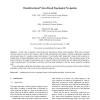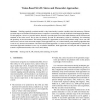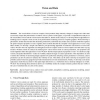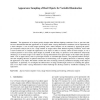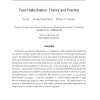107
Voted
IJCV
2007
15 years 4 days ago
2007
The physical (microtomy), optical (microscopy), and radiologic (tomography) sectioning of biological objects and their digitization lead to stacks of images. Due to the sectioning ...
130
Voted
IJCV
2007
15 years 4 days ago
2007
Robots often incorporate computational models of visual attention to streamline processing. Even though the number of visual attention systems employed on robots has increased dram...
164
Voted
IJCV
2007
15 years 11 days ago
2007
Abstract. In this work we present a novel system for autonomous mobile robot navigation. With only an omnidirectional camera as sensor, this system is able to build automatically a...
128
Voted
IJCV
2007
15 years 11 days ago
2007
Building a spatially consistent model is a key functionality to endow a mobile robot with autonomy. Without an initial map or an absolute localization means, it requires to concurr...
118
Voted
IJCV
2007
15 years 11 days ago
2007
Autonomous mobile robot navigation, either off-road or on ill-structured roads, presents unique challenges for machine perception. A successful terrain or roadway classifier must ...
123
Voted
IJCV
2007
15 years 16 days ago
2007
The visual effects of rain are complex. Rain produces sharp intensity changes in images and videos that can severely impair the performance of outdoor vision systems. In this paper...
131
Voted
IJCV
2007
15 years 16 days ago
2007
Abstract. The appearance of an object greatly changes under different lighting conditions. Even so, previous studies have demonstrated that the appearance of an object under varyin...
110
Voted
IJCV
2007
15 years 16 days ago
2007
Humans have an amazing ability to instantly grasp the overall 3D structure of a scene – ground orientation, relative positions of major landmarks, etc – even from a single ima...
118
Voted
IJCV
2007
15 years 16 days ago
2007
In this paper, we study face hallucination, or synthesizing a high-resolution face image from an input low-resolution image, with the help of a large collection of other high-reso...
107
Voted
IJCV
2007
15 years 16 days ago
2007
In this paper, we propose a stereo method specifically designed for image-based rendering. For effective image-based rendering, the interpolated views need only be visually plaus...

